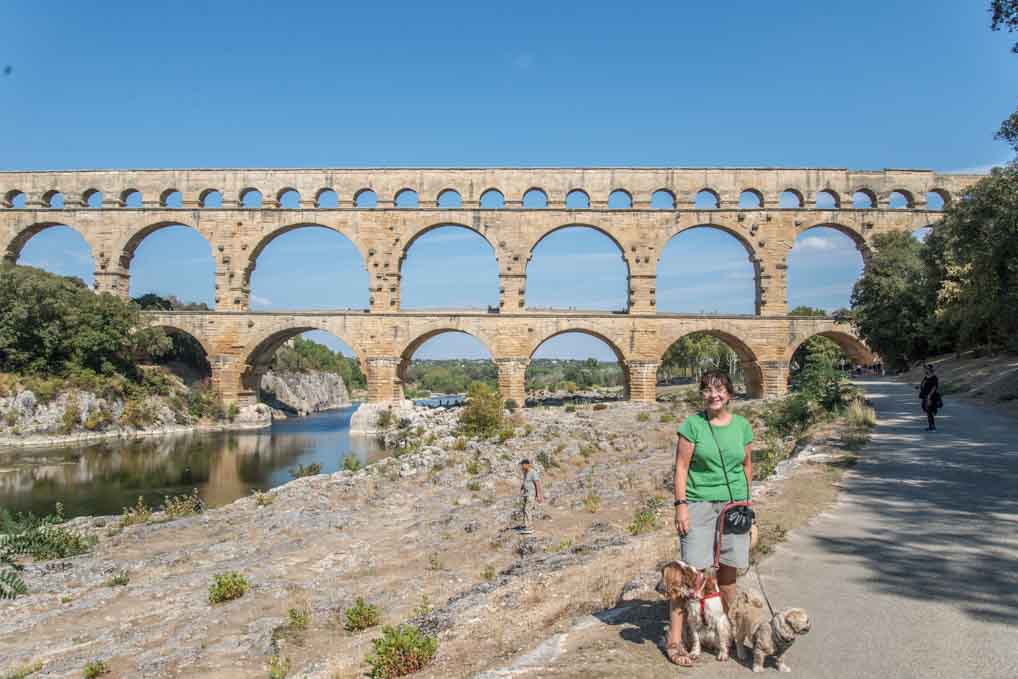Team Basil has finally shaken off the lingering effects of both man flu and lady flu. Well almost.
Sarah took the dogs out for their normal morning constitutional and managed to get herself lost – again. I was impressed that she managed to locate her position using her iPhone and navigating her way back, at one time using the sun to help with direction. I’m not sure about this last claim, it seems a bit too Bear Grills for Sarah!
When she reappeared after an hour we decided we would take Basil out for the day, as a treat. Our destination was to be a famous Roman bridge carrying an aqueduct, called the Pont du Gard. It was only 18 miles and better still there was a LIDL en route.
So after breakfast we unplugged Basil’s electricity umbilical, turned off the gas and off we set.
The Provencal countryside is still lovely at this time of year. The trees are turning orange and some of the grape vines are changing into a deep red. But despite these signs of autumn the light is still fantastic. No wonder artists over the years have moved to Provence to paint.
Our stops at LIDL have now been honed into a smoothly run operation. We have a standard list of groceries from which we make up a bespoke list for each shop. Sarah flies in to grab the standard groceries while I look after the dogs and then we swap while I shop for any necessary alcohol. There is always necessary alcohol!
After LIDL we drove the remaining distance to a large car park near the Pont du Gard. Sarah and I visited this aqueduct 28 years ago and then you could drive to within sight of the bridge, park up and you were then free to explore the bridge, on all levels, for no charge. Things have changed a bit. Huge new car parks have been built on both sides of the bridge and the only way to get close enough to the bridge, even to just take a photograph, is to pay the minimum €8.50 entrance fee, which includes parking. There are extra charges to go on the top deck, but this has to be with a guided tour and no longer are you allowed to walk on top of the vertigo inducing third layer; the guided tour is limited to exploring the aqueduct channel. Having done the third layer 28 years ago, including for Sarah walking on the roof of the aqueduct, for which I did not have the necessary head for heights, we opted for the cheapest price.

Pont du Gard
It is actually pretty good value by comparison with some UNESCO World Heritage sites we have visited this trip ( yes this is yet another one). Apart from the bridge there is a large area of beautiful river valley to explore and a museum, which also did not exist when we last visited.

View from the Pont du Gard
To my eyes the Pont du Gard is one of the wonders of the ancient world. Built 1980 years ago, it was part of a 51 kilometer aqueduct to carry water to the Roman city, which is now called Nimes. The engineering difficulties were considerable, including the need to carry the water over the large gorge of the River Gard. It is 49 metres (160 feet) high and 275 metres (900 feet) long. It consists of three layers of arches, one sitting on top of the other and the bottom two layers were built without using mortar, just relying on a friction fit between the limestone blocks. In order to ensure the water flowed at the right rate for the whole 51 kilometres of the aqueduct, the Pont du Gard had to ensure that there was just a 2.5 cm height difference between one end of the bridge and the other, a gradient of about 1 in 19,000! All with the tools of the day. The Romans were brilliant engineers. And to cap it all it is still standing. It is the highest bridge the Romans ever built.

Sarah and the dogs pose
The setting for the bridge is beautifully picturesque, set in a lovely gorge with a river (of course) flowing though it. Today it was pleasantly quiet, but that is not the case in the height of the summer.

Pont du Gard
There is nothing much else to do but to walk across the bridge and up and down the gorge to admire the engineering skills of the builders and the beauty of the bridge.

Old mill on the River Gard
I also nipped into the museum, which is pretty informative. There is plenty of written material and a few exhibits. The highlight for me was as series of reproduction lead plumbing fixtures, which showed how sophisticated the Romans were in taking the 9 million gallons a day transported by aqueduct and distributed it throughout the city of Nimes – to individual houses; communal buildings such as baths; civic features like fountains; and to communal toilets.
Walking back from the bridge to Basil I had my second highlight of the day, a French man wearing a knotted handkerchief on his head! Younger readers may not be aware of this fashion accessory, but in the not too distant past, men of a certain age, especially those who were losing their hair, would, when the sun got too hot, tie a knot at each corner of a handkerchief and wear it on their head. I promise I am not making this up. It frequently featured in seaside towns though out Britain and it was great to see that the French are keeping up the tradition.
